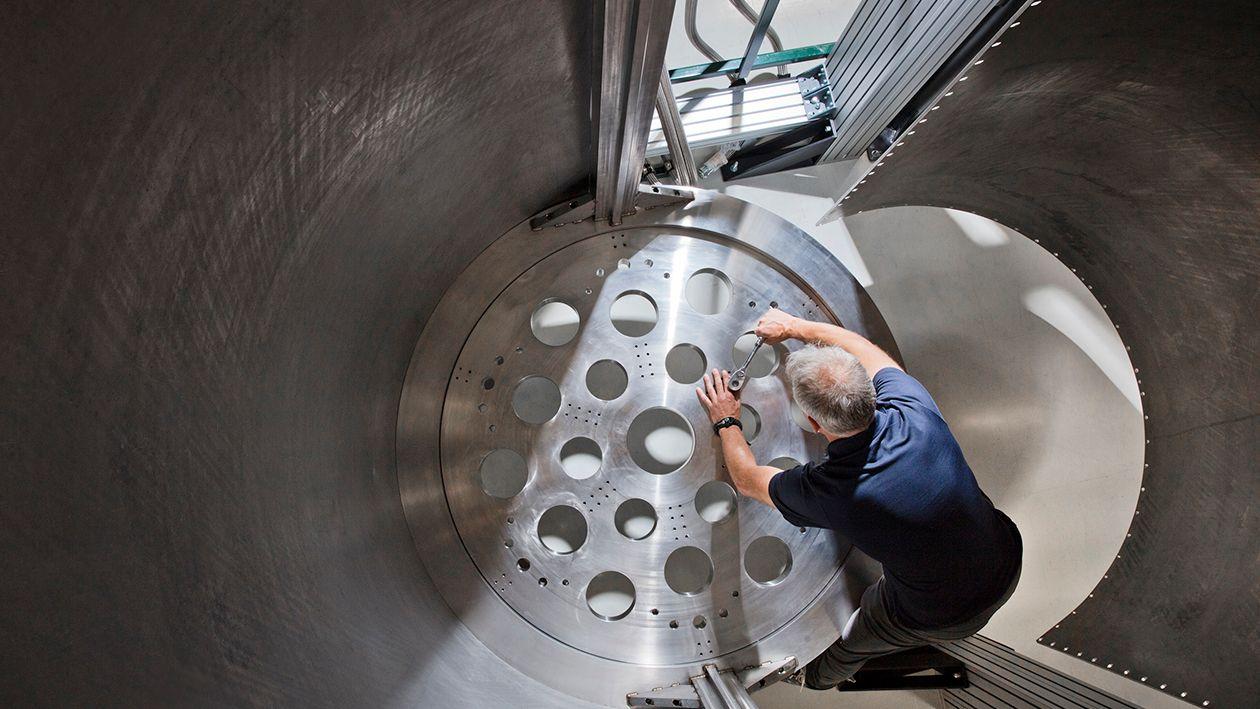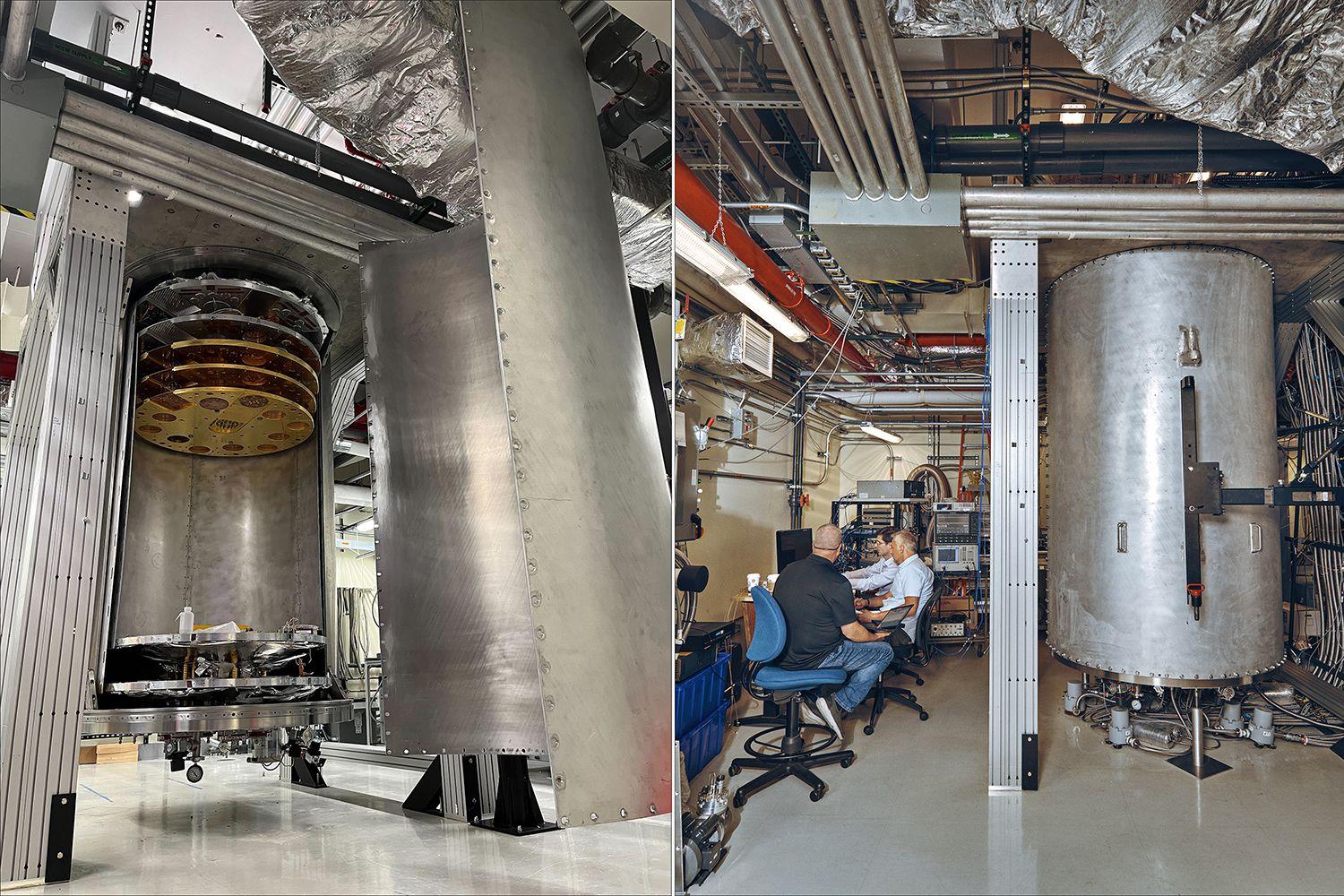
This is a huge volume which allows large devices to be tested and operated. This is another century of technical evolution.
All good.
It will be interesting to see what comes out of this.
.
IBM scientists cool down the world’s largest quantum-ready cryogenic concept system
Project Goldeneye pushes the limits of low-temperature refrigeration while laying the groundwork for the quantum industry’s ability to scale to larger experiments.
https://research.ibm.com/blog/goldeneye-cryogenic-concept-system?
Pictured: Pat Gumann, IBM Research staff member, and Goldeneye technical lead, adjusts the bottom of the "super-fridge,” a dilution refrigerator larger than any commercially available today. (Credit: Connie Zhou for IBM.)
Project Goldeneye pushes the limits of low-temperature refrigeration while laying the groundwork for the quantum industry’s ability to scale to larger experiments.
We create knowledge by exploring reality’s frontiers: we study the coldest, the furthest, the lowest and highest energies, and the smallest things in the universe. But reaching these frontiers is no small feat — typically, it requires building all-new apparatuses that push the limits of modern technology. That’s why we built the world’s largest dilution refrigerator by experimental volume.
The super-fridge — internally known as project Goldeneye — is a proof-of-concept for a dilution refrigerator, capable of cooling future generations of quantum experiments. Today’s dilution refrigerators are limited in a number of ways: the size of the quantum physics experiments we can fit inside them; the number of input/output ports; their cooling power. Goldeneye may not be slated for use with any of the IBM Quantum processors we're developing today, but building it taught us important lessons on how to overcome these challenges.
Goldeneye is a testament to the fact that a small team of people armed with passion and dedication can move a seven-ton “mountain” of steel and electronics. The super-fridge contains 1.7 cubic meters’ worth of experimental volume, meaning it can cool a volume larger than three home kitchen refrigerators to temperatures colder than the outer space, versus previous fridges, which are in the range of 0.4-0.7 cubic meters.
These temperatures are required for performing state-of-the-art physics experiments and potentially running large quantum processors.
the super-fridge is a proof-of-concept for a dilution refrigerator capable of cooling future generations of quantum experiments.
Today, we’re excited to announce the culmination of Project Goldeneye’s mission: we successfully cooled it to operating temperature (~25 mK) and wired a quantum processor inside. Goldeneye will soon move to our IBM Quantum Computation Center in Poughkeepsie, NY, where the team will be exploring large scale cryogenic systems to best develop the cooling needs of tomorrow’s quantum data centers, such as the Bluefors Kide platform under development for use with IBM Quantum System Two. We hope that its innovative design, with an eye toward ease-of-use, will inspire the next generation of vacuum and low temperature refrigeration technologies.
How to build the world’s largest, coldest fridge
Studying and controlling quantum effects requires that we have access to the temperature regime where the effects are most visible — temperatures close to those at which there is zero energy, called 0 Kelvin (K) or absolute zero. Dilution refrigerators are experimental cryogenic devices that cool a space volume to the milli-Kelvin (mK) regime, using a mixture of two helium isotopes, called helium-3 (He-3) and helium-4 (He-4).
Dilution refrigerators perform this cooling by using a number of steps to remove heat from the helium isotope mixture, and then use vacuum pumps to circulate and dilute He-3 into the He-3/He-4 mixture until a target temperature is reached. Until recently, all dilution refrigerators were “wet” systems, requiring already-cold substances like liquid nitrogen and other cryogenic fluids to begin the cooling. Today’s fridges are more commonly “dry,” employing a mechanical component called a cryo-cooler to provide the initial 50 K and 4 K temperatures for pre-cooling the helium mixture.
These are advanced pieces of machinery, and thus challenging to scale. Project Goldeneye features an all-new construction of the frame and cryostat — the main, barrel-shaped component responsible for the cooling — to maximize experimental volume while reducing noise and achieving the temperatures required for cooling experimental quantum hardware. The design is modular, which made prototyping, assembly, and disassembly a much easier lift for just a team of four IBM engineers. Other large dilution refrigerators may require larger cranes and a dozen or more technicians for assembly and disassembly.
The cryostat also features a clamshell design, allowing the outer vacuum chamber to open sideways and eliminating the need to remove the entire external shell to access the hardware inside. Most dilution refrigerators in use today require a team of operators to function properly, but Goldeneye’s fully automated system includes a specially designed jib crane that could one day allow even a single person to run the fridge — which can be monitored remotely with the help of an open-source visualization platform.

L: Interior of Goldeneye experimental superfridge. R: IBM Quantum’s Goldeneye team.
The inside of the cryostat features the ability to install a set of 10 internal plates for mounting components in its top and bottom half: five “regular” units on top and five inverted units on the bottom. It can also hold up to six individual dilution refrigerator units, enabling close to ~10 mW at 100 mK cooling power, and over 24 W of cooling power at 4 K temperatures. Finally, the weight of the entire system — 6.7 metric tons — also helps dampen vibrations, reducing the need for other commonly used dampening techniques.
Most importantly, it works. After just three years from project inception to our recent 25 mK milestone, we were able to perform one final characterization exercise: we put a qubit chip inside.
This test demonstrated the performance of Goldeneye through the eyes of a qubit by measuring qubit frequencies and coherence times — how long they can retain quantum information. We were able to reproduce coherence times of around 450 microseconds, similar to those measured on other commercial dilution refrigeration systems. We did not observe a decrease in the qubit’s performance despite the different internal environment and much larger experimental volume.
And despite its size, Goldeneye is efficient. It requires less space than present-day, large-scale dilution refrigerators1 in order to accommodate an equivalent amount of quantum hardware. It would require 10 times the lab space to deploy equivalent hardware in today’s state-of-the-art fridges.
We don’t know if the fridges used to cool future quantum computers will actually be this large. IBM Quantum System Two, which we will deploy next year, will first be realized with Bluefors’ Kide cryogenic platform, a smaller, modular system that we anticipate will allow us to already connect multiple processors together Expanding the IBM Quantum roadmap to anticipate the future of quantum-centric supercomputing. Read more.through 2025. However, having access to Goldeneye allows us to consider many different ways of scaling up our quantum processors even beyond 2025, and will help us further conceptualize the cryogenic infrastructure of tomorrow's quantum data centers.
IBM Quantum System Two: Design Sneak Preview
Most importantly, every time we push a technological boundary, we learn something new. By simply constructing Goldeneye, our team has tested the limits of cryogenic science, while teaching us what kinds of large-scale quantum experiments may soon be feasible. The lessons learned from this project will likely go towards a future IBM Quantum System Three as we continue to chart the course of quantum for the world.
No comments:
Post a Comment